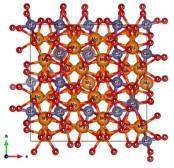Is a New Phase of Mineral a Clue to Internal Dynamics of a “Super Earth”?
Astronomers have discovered thousands of planets orbiting other stars. Many of these planets are rocky like Earth, but considerably bigger. Researchers wonder if these “Super Earths” could support life. One of the requirements for life as we know it is plate tectonics, the slow churning of a planet’s interior that renews the surface, regulates the carbon cycle, and keeps liquid water available. Now, researchers have used the U.S. Department of Energy's Advanced Photon Source (APS) to understand how common silicate minerals would behave under the incredible pressures deep in the mantle of a Super Earth. Their findings, published in the Proceedings of the National Academy of Sciences of the United States of America, reveal a new phase of mineral never before reported.
Magnesium silicates are common minerals that comprise the bulk of rocky planets. Geophysicists have a fairly good understanding of how magnesium (and iron) silicates behave inside of the Earth: They form a mineral phase called bridgmanite in the Earth's deep mantle and this defines a major structural boundary in our planet. But under the extraordinarily high pressures in the mantle of a Super Earth, researchers suspect magnesium and iron silicates would form a mineral phase with a structure similar to that of thorium phosphide. Unfortunately, we have no way to reproduce those pressures in the lab.
However, geophysicists can study magnesium germanates instead. Germanium is chemically akin to silicon, sitting directly beneath it in the periodic table. But its larger size makes it more easily compressible, and magnesium germanates pass through the same phase transitions as magnesium silicates do, at lower pressures.
A team of researchers from the Carnegie Institution for Science, Princeton University, University of Nevada Las Vegas, and The University of Chicago used a laser-heated diamond anvil to compress magnesium germinate (Mg2GeO4) to pressures as high as 275 gigapascals (GPa). X-ray beamlines at the APS operated by the GeoSoilEnviroCARS collaborative access team (beamline 13-ID-D) and the Argonne X-ray Science Division's HPCAT-XSD (beamline 16-ID-B) were both used for various parts of the experiment. This was the first time x-ray diffraction was performed in situ at such high pressures on a germanate, and it was done in remote access mode using NoMachine’s NX software at HPCAT-XSD.
See: Rajkrishna Dutta1, 2, Sally June Tracy1, R. E. Cohen1, Francesca Miozzi1, Kai Luo1, Jing Yang1, Pamela C. Burnley3,Dean Smith4, Yue Meng4, Stella Chariton5, Vitali B. Prakapenka5, and Thomas S. Duffy2, “Ultrahigh-pressure disordered eight-coordinated phase of Mg2GeO4: Analogue for super-Earth mantles,” Proc. Natl. Acad. Sci. U.S.A. 119 (8), e2114424119 (February 14, 2022). DOI: 10.1073/pnas.2114424119

